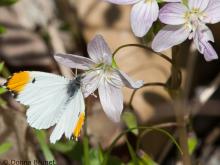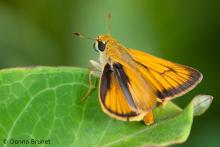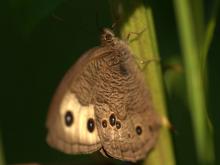Butterflies and Moths
Media

Species Types
Scientific Name
Colias philodice
Description
The clouded sulphur is one of our most common butterflies, flying low over fields and lawns, from late March into December.
Media

Species Types
Scientific Name
Phoebis sennae
Description
The cloudless sulphur is the large, clear-yellow butterfly you see flying rapidly to the southward in late summer and fall: They’re migrating!
Media

Species Types
Scientific Name
Anthocharis midea
Description
Falcate orangetip males are unmistakable with their small size, white coloration, and orange wingtips. Look for them in open woodlands in April.
Media

Species Types
Scientific Name
Anatrytone logan
Description
The undersides of the Delaware skipper's wings are solid orange. It's found statewide in a variety of habitats.
Media

Species Types
Scientific Name
Hylephila phyleus
Description
Fiery skippers have plain orange undersides scattered with a sprinkling of small dark spots. Males have flame-shaped orange patches on the hindwing upper surface.
Media

Species Types
Scientific Name
Polites peckius
Description
Peck’s skipper is found in Missouri’s fields, lawns, and other open habitats from May through October. Identify it by the one yellow hindwing rectangle that is wider than the others.
Media

Species Types
Scientific Name
Euphydryas phaeton ozarkae
Description
The Baltimore checkerspot is unforgettable. In Missouri it is locally abundant in the eastern Ozarks, but rare elsewhere.
Media

Species Types
Scientific Name
Cercyonis pegala
Description
Common wood nymphs vary by region. Some have a yellow area on the forewing containing two eyespots. Others may have the yellow area reduced to a yellow circle around each eyespot.
Media

Species Types
Scientific Name
More than 12,000 species in North America north of Mexico
Description
Learn about moths as a group. What makes a moth a moth? How are moths different from butterflies? What are the major groups of moths?
See Also


Media

Species Types
Scientific Name
About 1,500 species in North America north of Mexico
Description
Adult caddisflies are mothlike. Their larvae are aquatic and build portable, protective cases out of local materials, including grains of sand, bits of leaves and twigs, and other debris.
Media

Species Types
Scientific Name
Corydalus cornutus
Description
Adult eastern dobsonflies are huge and mothlike, with large wings and a weak, fluttery flight. The fiercely predaceous aquatic larvae, called hellgrammites, are well-known to anglers, who often use them as bait.
About Butterflies and Moths in Missouri
Butterflies, skippers, and moths belong to an insect order called the Lepidoptera — the "scale-winged" insects. These living jewels have tiny, overlapping scales that cover their wings like shingles. The scales, whether muted or colorful, seem dusty if they rub off on your fingers. Many butterflies and moths are associated with particular types of food plants, which their caterpillars must eat in order to survive.





















